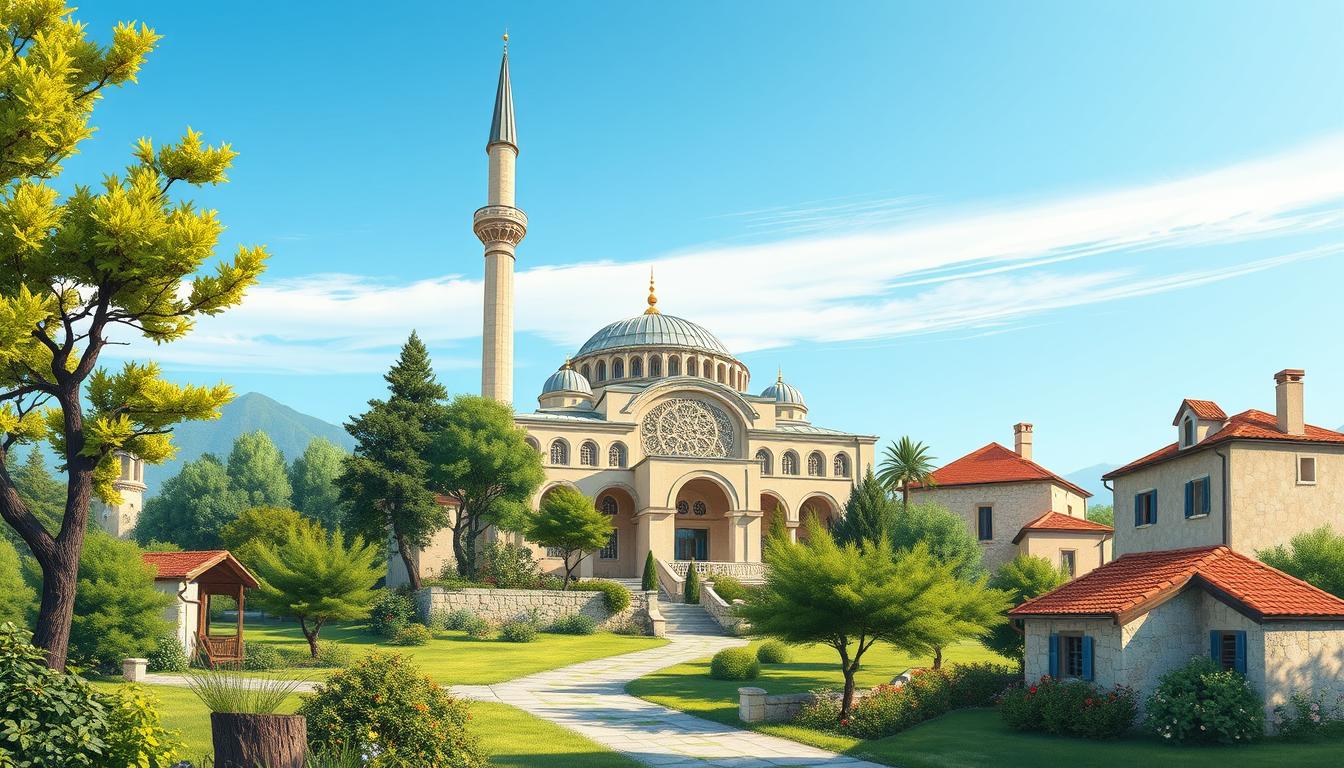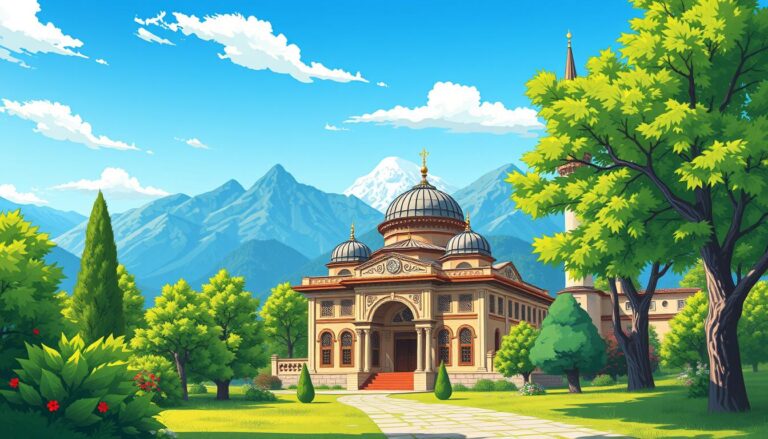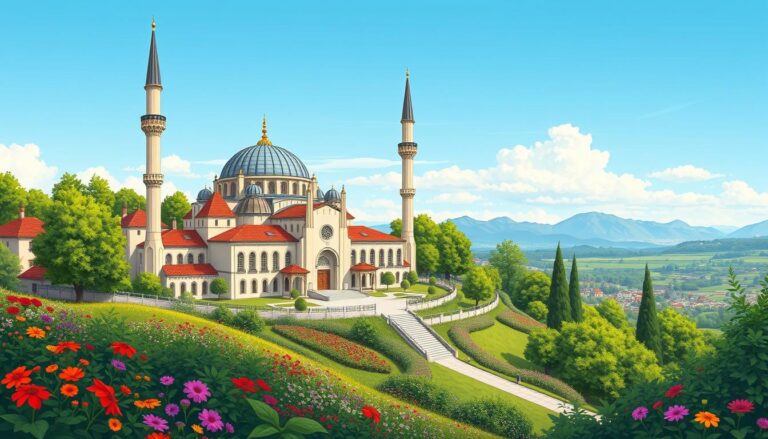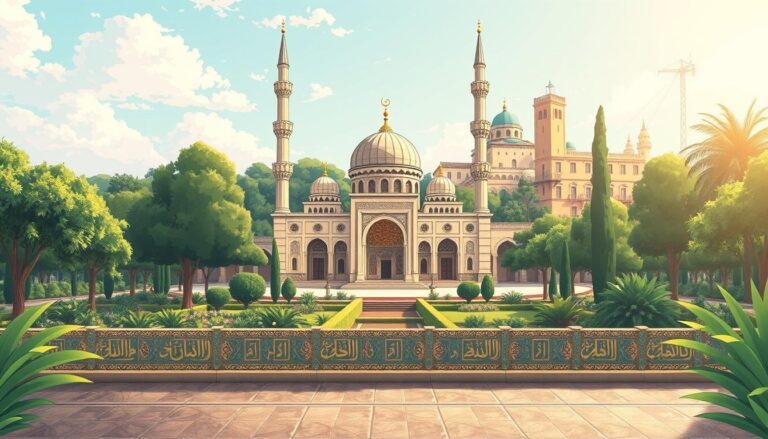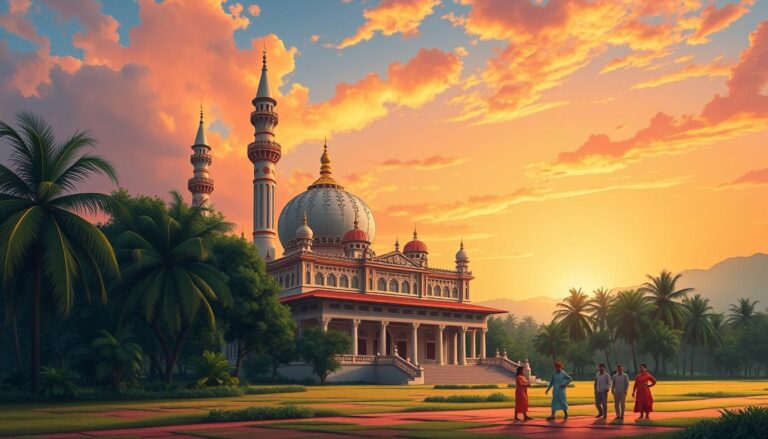Islam in Croatia
According to the 2021 census, Islam is followed by a mere 1.3% of Croatia’s population. Yet, the history of Islam in this Balkan nation is far more expansive and compelling than this statistic might suggest. From the Croatian-Ottoman wars of the 15th and 16th centuries to the recent influx of Bosnian immigrants, the presence of Islam in Croatia has left an indelible mark on the country’s cultural and religious landscape.
Key Takeaways
- Islam was first introduced to Croatia during the Croatian–Ottoman Wars from the 15th to 16th century, when parts of the Croatian Kingdom were occupied by the Ottoman Empire.
- Despite the presence of Islam, Croats strongly fought against the Turks during these centuries, leading to the westernmost border of the Ottoman Empire in Europe becoming entrenched on Croatian soil.
- In 1519, Croatia was called the “Antemurale Christianitatis” by Pope Leo X, highlighting its role as a bulwark against the Ottoman expansion.
- The Muslim population in Croatia increased steadily after the disintegration of Yugoslavia between 1991 and 1995, mostly comprising immigrants of Bosnian origin.
- Today, Islam in Croatia is represented by a diverse community, with Sunni Muslims and Sufi traditions both playing a significant role.
Introduction
Islam has a long and fascinating history in Croatia, dating back to the Ottoman conquest of parts of the Croatian Kingdom in the 15th and 16th centuries. During this period, some Croats converted to Islam, either as prisoners of war or through the devşirme system, which required the periodic collection of Christian children to be raised as Ottoman soldiers and administrators.
Although Islam remains a minority presence in the predominantly Christian country, it has left an indelible mark on Croatian culture and architecture. Today, Muslims constitute approximately 1.3% of Croatia’s population, with the community representing diverse groups such as Bosniaks, Albanians, Roma, Turks, Macedonians, and Montenegrins.
The Growth of the Muslim Population
The Muslim population in Croatia has fluctuated over the years. According to census data, there were 1,239 Muslims in 1931, 16,185 in 1953, and 43,486 in 1991, reflecting growth due to immigration from Bosnia and Herzegovina. In the 2001 census, the Muslim population was recorded at 57,687 individuals, or around 1.3% of the total population.
The 2021 census shows that the Muslim population in Croatia has remained relatively stable, with 1.3% of the population identifying as followers of Islam. The majority of Croatian Muslims are Bosniaks, with other significant groups including Albanians, Roma, Turks, Macedonians, and Montenegrins.
“Islam has left a lasting impact on Croatian culture and architecture.”
Significant mosques and Islamic centers can be found in cities like Zagreb and Rijeka, with plans to build additional mosques in other parts of the country. The Muslim community in Croatia is officially recognized and led by the Islamic Community of Croatia, which is acknowledged by the state.
Historical Background
The Ottoman Empire’s conquest of parts of Croatia from the 15th to the 19th century left a lasting impact on the country’s religious landscape. During this period, many Croats converted to Islam, some as prisoners of war and others through the Ottoman’s devşirme system, which conscripted young Christian boys into the Ottoman military and administrative ranks.
The westernmost border of the Ottoman Empire in Europe became firmly established on Croatian soil, earning the region the title “Antemurale Christianitatis” (Bulwark of Christendom) from Pope Leo X in 1519. This strategic position on the frontlines of the Christian-Muslim divide led to centuries of Croatian-Ottoman conflicts, known as the Croatian-Ottoman Wars.
Ottoman Rule and the Spread of Islam
The Ottoman occupation of Croatia saw a gradual but significant Islamization of Croatia. Mosques were built, and many Croats converted to the Islamic faith, either willingly or under duress. The Ottoman Empire in Croatia played a crucial role in shaping the country’s religious and cultural identity, with lasting implications that continue to be felt today.
“The westernmost border of the Ottoman Empire in Europe became entrenched on Croatian soil, leading to the region being called the ‘Antemurale Christianitatis’ (Bulwark of Christendom) by Pope Leo X in 1519.”
The Croatian-Ottoman Wars that ensued during this period further solidified the complex relationship between the two powers, shaping the religious and cultural landscape of Croatia in the centuries that followed.
Croat Muslims
Croatia’s Muslim population, known as Croatian Muslims or Hrvatski muslimani, are primarily the descendants of Croats who converted to Islam during the Ottoman Empire’s rule over the region. According to the 2021 Croatian census, 10,841 Muslims in the country declared themselves as ethnic Croats, making up a small but significant portion of the nation’s diverse religious landscape.
The Islamic Community of Croatia is the main organization that represents Muslims in the country and is officially recognized by the Croatian state. This community plays a vital role in preserving the cultural and religious traditions of Croatian Muslims and Bosniak Muslims in Croatia, as well as other Muslim ethnicities in Croatia.
“The history of Croatia has been shaped by the coexistence and interaction of various religious and ethnic communities, including the Muslim population, who have made valuable contributions to the country’s cultural heritage.”
While the Croatian Muslims constitute a small minority within the overall population, their presence and influence have been significant in shaping the country’s religious and cultural diversity. The integration of Muslim traditions and practices into the broader Croatian society has been an ongoing process, marked by both challenges and opportunities for mutual understanding and respect.
Islam in Croatia by the Numbers
The Muslim population in Croatia has fluctuated over the years, reflecting the country’s dynamic religious landscape. According to census data, the Islam demographics in Croatia have seen significant changes:
- 1931: 4,750 Muslims
- 1948: 1,077 Muslims
- 1953: 16,185 Muslims
- 1961: 3,113 Muslims
- 1971: 18,487 Muslims
- 1981: 23,740 Muslims
- 1991: 43,486 Muslims
- 2001: 56,777 Muslims
- 2011: 62,977 Muslims
- 2021: 50,981 Muslims
These figures highlight the evolving nature of the Muslim population in Croatia, reflecting factors such as migration, demographic shifts, and the country’s complex religious and cultural dynamics. While the Islam demographics in Croatia have fluctuated over the decades, the Islamic community continues to play a significant role in the country’s social, cultural, and religious landscape.
“The Muslim-Bosniak minority in Croatia numbered approximately 43,469 according to the 1991 population census.”
The Islamic community in Croatia became independent from Bosnia and Herzegovina in 1991, establishing a Meshihat as the highest executive body. This organization plays a crucial role in the cultural, religious, and socio-political life of Bosniaks and other Muslim populations in the country.
In the most recent census data from 2011, 1.47% of the population in Croatia identified as Muslim, totaling 62,977 individuals. This figure highlights the continued presence and significance of the Muslim population in Croatia, contributing to the country’s diverse religious landscape.
Mosques and Islamic Architecture
Croatia boasts a rich tapestry of Islamic architecture, reflecting the country’s diverse cultural heritage. The first modern mosque in Croatia was built in the town of Gunja in 1969, marking an important milestone in the history of Mosques in Croatia. Today, the country is home to 4 mosques and 2 Islamic centers, primarily located in Zagreb and Rijeka.
Historically, during the Ottoman rule, Croatia witnessed a significant presence of mosques, with up to 250 structures at one point. However, many of these Ottoman-era mosques were systematically destroyed after the Treaty of Karlowitz. One of the few remaining examples of this architectural legacy is the Ibrahim Pasha’s Mosque, situated in the eastern Croatian town of Đakovo. Interestingly, this mosque is now utilized as a Roman Catholic church, showcasing the evolving nature of religious spaces in the country.
Notable Mosques and Islamic Centers
The Gunja Mosque, completed in 1969, is the oldest active mosque in Croatia. This house of worship has witnessed a remarkable transformation, with its current dome constructed in 1999 based on a Neo-Ottoman design. The mosque’s significance extends beyond its architectural features, as it has played a crucial role in the lives of the local Muslim community, organizing annual Evenings of Spiritual Music that bring together students, Serbian Orthodox, and Roman Catholic representatives.
The mosque in Rijeka, completed in 1987, is the third mosque in Croatia and the first one in the city. This impressive structure, designed by the late sculptor Dušan Džamonja in collaboration with architects Darko Vlahović and Branko Vučinović, is considered a building of high international artistic relevance. The mosque’s unique design, featuring five domes and semi-domes, creates a functional sculpture-like appearance, reflecting the community’s willingness to establish itself within modern society.
“The mosque showcases the flexibility and willingness of a traditional Islamic community to establish itself within modern society.”
Islam in Croatia
Islam has a long and fascinating history in Croatia, tracing back to the Ottoman conquests of the 15th and 16th centuries. During this period, many Croats converted to Islam, either as prisoners of war or through the devşirme system of the Ottoman Empire. While Islam is a minority religion in Croatia today, it has left an indelible mark on the country’s culture and architecture.
According to the 2021 Croatian government census, Islam is practiced by approximately 1.3 percent of the population. The majority of Croatians, around 79 percent, identify as Catholic, with Serbian Orthodox Christians making up 3.3 percent. The Muslim population in Croatia has fluctuated over the years, reaching a high of 62,977 in 2011 before declining to 50,981 in the latest census.
The Islamic Community of Croatia is the main organization representing Muslims in the country, and it is officially recognized by the state. The community is led by Mufti of Zagreb, Imam Aziz Hasanović, and is responsible for preserving Islamic practices and traditions within the Muslim communities in Croatia.
While the Islamic practices in Croatia may differ from other parts of the world, the country’s Muslim population continues to play a vital role in shaping its cultural and religious landscape. From the historic mosques to the influence on art and architecture, Islam in Croatia remains an integral part of the nation’s rich tapestry.
“Islam has left an indelible mark on the country’s culture and architecture.”
Prominent Croat Muslim Figures
Throughout Croatia’s history, there have been several notable who have made significant contributions. These have left an indelible mark on the nation’s cultural and political landscape.
One such figure is Rüstem Pasha Hrvat, an who served as Grand Vizier during the reign of Ottoman Sultan Ahmed I. Pasha Hrvat played a crucial role in shaping Ottoman policies and diplomacy during his tenure.
Another prominent was Piyale Pasha, a military commander of Croat origin who distinguished himself in the Ottoman Empire’s military campaigns. Piyale Pasha’s leadership and strategic acumen earned him a place among the of his time.
During World War II, Džafer-beg Kulenović, a Muslim, served as the vice-president of the Independent State of Croatia. His involvement in this controversial era underscores the complex and their role in the nation’s political developments.
“These have left an indelible mark on the nation’s cultural and political landscape, showcasing the rich and their significant contributions.”
Integration and Challenges
The integration of Muslims in Croatia has faced some unique challenges over the years. During the Ustaše regime in the Independent State of Croatia during World War II, the Ustaše recognized both Roman Catholicism and Islam as the national religions of the Croatian people, but they also attached certain conditions to citizenship for people of Islamic faith, requiring Muslims to assert their Croatian identity.
In the post-war period, the Communist government’s attitude towards religion and religious communities changed drastically, leading to the demolition of the minarets of the Zagreb Mosque in 1947. Despite these obstacles, the Muslim community in Croatia has continued to maintain its presence and identity within the predominantly Christian country.
The Muslim community in Croatia represents only 1.5% of the total population, with around 60,000 individuals out of a total of 4.5 million. However, Croatia is an exceptional case where Muslims have established a unified organizational structure, the Islamic Community in Croatia (ICC), despite being a traditionally non-Muslim part of Europe.
While the Muslim community in Croatia has faced challenges, it has also played a role in shaping the country’s cultural and religious landscape. The arrival of Christianity in Croatia dates back to the 7th century, and there is historical evidence of Saint Paul’s shipwreck on the Island of Mljet. Croatia recognized Islam as a registered faith in 1916, being the second country in Europe to do so.
“Croatia signed four international treaties with the Holy See after gaining independence in 1991, reflecting the importance of religious life in the country’s post-independence development.”
The integration of Muslims in Croatia remains an ongoing process, with both challenges and opportunities for the community to contribute to the country’s cultural and religious diversity.
Cultural Influences
The presence of Islam in Croatia has had a profound impact on the country’s rich cultural heritage. During the Ottoman rule, a significant number of Croats converted to Islam, leading to the integration of Islamic elements into Croatian architecture, cuisine, and various aspects of cultural life. This interweaving of Islamic and Croatian influences has created a unique cultural tapestry that continues to shape the identity of the nation.
Impact of Islam on Croatian Culture
One prime example of this cultural exchange is the Ibrahim Pasha’s Mosque in Đakovo. Originally built as an Ottoman mosque, it is now used as a Roman Catholic church, symbolizing the seamless integration of Islamic and Christian traditions in Croatia. This architectural gem is a testament to the country’s ability to embrace diversity and find common ground between different faiths and cultures.
Furthermore, the influence of Islam can be seen in the country’s cuisine, with dishes like ćevapčići (grilled minced meat) and burek (filled pastry) becoming staples in Croatian culinary culture. These gastronomic delights, once associated with the Ottoman legacy, have now become integral parts of the national identity, showcasing the enduring Islamic influence on Croatian culture.
The Muslim cultural heritage in Croatia is also evident in the country’s vibrant artistic expressions, from traditional textiles and ceramics to intricate calligraphy and metalwork. These artistic traditions have been passed down through generations, blending the Islamic aesthetic with local Croatian influences to create a unique and captivating cultural tapestry.
“The cultural exchange between Islam and Croatia has enriched the country’s identity, creating a tapestry of diverse influences that continue to shape the nation’s trajectory.”
Legal Status and Recognition
In Croatia, the legal recognition of Islam has a long and storied history. Back in 1912, the Austrian Imperial Council granted Islam the status of a recognized religion, equal to all others in the Austro-Hungarian monarchy. This landmark decision was later confirmed by the Croatian Parliament, which passed a law in 1916 recognizing Islam as an official religion in Croatia.
This groundbreaking legislation allowed Muslims to freely practice their religious beliefs in public, organize religious, cultural, educational, and funding institutions, and manage these establishments independently. Today, the Islamic Community of Croatia stands as the primary organization representing the country’s Muslim population, and it is officially recognized by the Croatian state.
“The law adopted in 1916 by the Parliament of the Kingdom of Croatia-Slavonia to recognize Islam has been praised for its wisdom and lasting impact.”
Croatia has long been a home to the three major monotheistic religions – Christianity, Judaism, and Islam. Over the past century, the Islamic community in Croatia has made significant contributions to the country’s heritage, economy, science, politics, culture, and sports. During the Homeland War, many Islamic believers sacrificed their lives for Croatia’s freedom, further solidifying their integral role in modern Croatian society.
The status of the Muslim community in Croatia is widely recognized as a model for other countries facing challenges with their Islamic communities. The Islamic Community in Croatia has consistently played a positive and constructive role in society, earning recognition and accolades from various entities, including the Office of the President, Croatian Parliament, and local governments.
In summary, the legal recognition of Islam in Croatia has a long and important history, dating back to the early 20th century. The Muslim community in Croatia is an integral part of the country’s diverse cultural landscape, and its contributions to various aspects of Croatian society have been widely acknowledged and celebrated.
Contemporary Issues
The Muslim community in Croatia continues to face certain current issues facing Muslim community in Croatia and debates and developments related to Islam in Croatia. After the fall of the Austro-Hungarian monarchy and the establishment of the Independent State of Croatia during World War II, the Ustaše regime’s treatment of Muslims as an integral part of the Croatian nation led to tensions and issues. In the post-war Communist era, the government’s attitude towards religion and religious communities underwent a significant shift, leading to the demolition of the minarets of the Zagreb Mosque.
Despite these historical challenges, the Muslim community in Croatia has continued to maintain its presence and identity, and ongoing discussions and developments related to the integration and recognition of the Muslim community in the country continue to take place. These debates and developments related to Islam in Croatia include issues such as the preservation of Islamic culture and heritage, the role of religion in public life, and the integration of the Muslim community within the larger Croatian society.
Ongoing Discussions and Developments
Some of the current issues facing Muslim community in Croatia and debates and developments related to Islam in Croatia include:
- The preservation of Islamic cultural and architectural heritage, including the maintenance and restoration of mosques and other religious structures.
- The recognition and integration of the Muslim community within the Croatian education system, with discussions around the inclusion of Islamic studies and the accommodation of religious practices.
- The role of Islam in public life and the ongoing dialogue between the Muslim community and the Croatian government on issues such as religious freedom and the representation of Muslim interests.
- The challenges faced by the Muslim community in terms of social and economic integration, including employment opportunities and representation in various sectors of Croatian society.
These debates and developments related to Islam in Croatia reflect the evolving landscape of the Muslim community’s presence and integration within the country, as the community continues to navigate the complexities of its historical legacy and contemporary realities.
Conclusion
The exploration of Islam’s presence in Croatia has revealed a rich and complex history, one that has been shaped by the country’s geopolitical landscape and the ebbs and flows of religious and cultural influences over the centuries. From the Ottoman conquests to the more recent challenges faced by the Muslim community, the role of Islam in Croatia’s diverse tapestry remains an integral part of the nation’s identity.
While Islam may be a minority faith, its impact on Croatian culture, architecture, and demographics is undeniable. The ongoing discussions and developments surrounding the integration and recognition of the Muslim community underscore the continued importance of understanding and appreciating the diverse religious and cultural makeup of this European nation.
As we reflect on the key takeaways from this exploration, it is clear that Islam has left an indelible mark on Croatia, contributing to its unique cultural heritage and serving as a testament to the resilience and adaptability of the Muslim community in the face of adversity. As Croatia continues to evolve, the role of Islam in shaping its future will undoubtedly remain a subject of importance and ongoing dialogue.
Source Links
- Croat Muslims
- Islam in the Croat Lands: Reflections from Croat Kingdom to Present Day – Maydan
- Islam in Croatia
- Islam in Croatia
- Islam in Croatia
- 169. The Fear of Islam In Croatian Politics
- Ethno-Religious Groups & Their Narratives
- Croatia – United States Department of State
- Croatia Religions – Demographics
- Islam and Muslims in Croatia: An Outline of the Making of Muslim/Bosniak Socio-cultural Space – DOAJ
- Gunja Mosque
- Al Fozan
- Islamic Architecture and Art in Croatia Ottoman and Contemporary Heritage
- Muslim Community in the Republic of Croatia
- The Muslim and Croat rebellion: c. April 1943–October 1943
- atlas of religious minority rights
- No title found
- Religious Beliefs In Croatia
- Religion in Croatia
- Parliament observes centennary of recognition of Islam in Croatia | Croatian Parliament
- Croatian Themes
- Transcript: Islam and the Modern State: The Bosnian Experience – Religious Freedom Institute
- Croatia – United States Department of State
- Bosnian War | Facts, Summary, Combatants, & War Crimes

